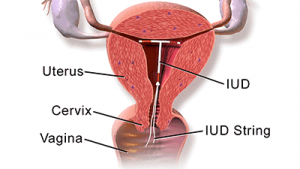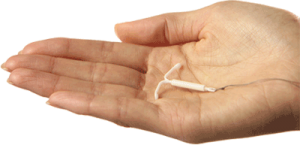IUD – Intrauterine Device for Birth Control
An IUD is a small, T-shaped plastic device that is wrapped in copper or contains hormones. The IUD is inserted into your uterus by your doctor. A plastic string tied to the end of the IUD hangs down through the cervix into the vagina. You can check that the IUD is in place by feeling for this string. The string is also used by your doctor to remove the IUD.

Types of IUDs
- Hormonal IUD. The hormonal IUD, such as Mirena or Skyla, releases levonorgestrel, which is a form of the hormone progestin. The hormonal IUD appears to be slightly more effective at preventing pregnancy than the copper IUD. There are two hormonal IUDs—one works for 5 years, and the other works for 3 years.
- Copper IUD. The most commonly used IUD is the copper IUD (such as Paragard). Copper wire is wound around the stem of the T-shaped IUD. The copper IUD can stay in place for up to 10 years and is a highly effective form of contraception.
How it works
Both types of IUD prevent fertilization of the egg by damaging or killing sperm. The IUD also affects the uterine lining (where a fertilized egg would implant and grow).
- Hormonal IUD.This IUD prevents fertilization by damaging or killing sperm and making the mucus in the cervix thick and sticky, so sperm can’t get through to the uterus. It also keeps the lining of the uterus (endometrium) from growing very thick.1 This makes the lining a poor place for a fertilized egg to implant and grow. The hormones in this IUD also reduce menstrual bleeding and cramping.
- Copper IUD. Copper is toxic to sperm. It makes the uterus and fallopian tubes produce fluid that kills sperm. This fluid contains white blood cells, copper ions, enzymes, and prostaglandins.

Insertion
You can have an IUD inserted at any time, as long as you are not pregnant and you don’t have a pelvic infection. An IUD is inserted into your uterus by your doctor. The insertion procedure takes only a few minutes and can be done in a doctor’s office. Sometimes a local anesthetic is injected into the area around the cervix, but this is not always needed.
IUD insertion is easiest in women who have had a vaginal childbirth in the past.
What To Expect After Treatment
You may have some mild cramping and light bleeding for 1 or 2 days.
Do not have sex, use tampons, or put anything in your vagina for the first 24 hours after you have an IUD inserted.
Follow-up
Follow up with your annual well woman exams.
Why It Is Done
You may be a good candidate for an IUD if you:
- Do not have a pelvic infection at the time of IUD insertion.
- Want an effective, long-acting method of birth control that requires little effort and is easily reversible.
- Cannot or do not want to use birth control pills or other hormonal birth control methods.
- Are breast-feeding.
How Well It Works
The IUD is a highly effective method of birth control.
- When using the hormonal or copper IUD, fewer than 1 woman out of 100 becomes pregnant in the first year.
- Most pregnancies that occur with IUD use happen because the IUD is pushed out of (expelled from) the uterus unnoticed. IUDs are most likely to come out in the first few months of IUD use, after being inserted just after childbirth, or in women who have not had a baby.
Advantages of IUDs include cost-effectiveness over time, ease of use, lower risk of ectopic pregnancy, and no interruption of foreplay or intercourse.
Other advantages of the hormonal IUD
- Reduces heavy menstrual bleeding by an average of 90% after the first few months of use. Reduces menstrual bleeding and cramps and, in many women, eventually causes menstrual periods to stop altogether. In this case, not menstruating is not harmful.
- May prevent endometrial hyperplasia or endometrial cancer.
- May effectively relieve endometriosis and is less likely to cause side effects than high-dose progestin.
- Reduces the risk of ectopic pregnancy.
- Does not cause weight gain.